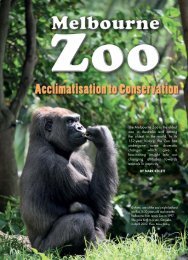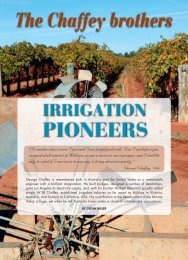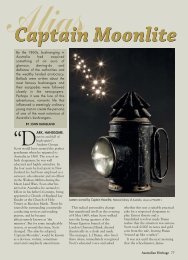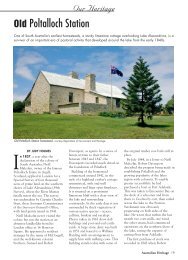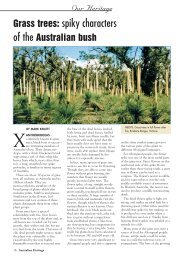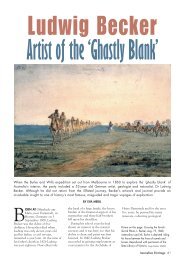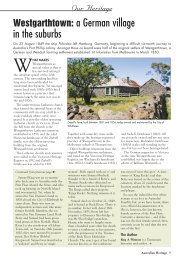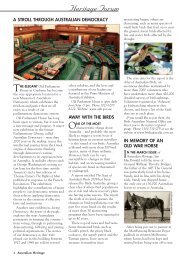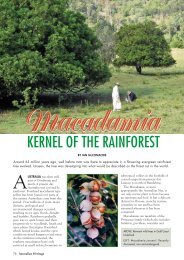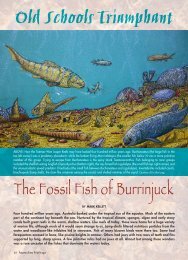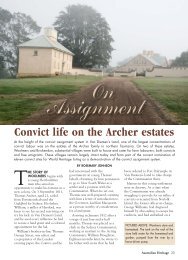Heritage 0609_Lord Howe.pdf - Australian Heritage Magazine
Heritage 0609_Lord Howe.pdf - Australian Heritage Magazine
Heritage 0609_Lord Howe.pdf - Australian Heritage Magazine
You also want an ePaper? Increase the reach of your titles
YUMPU automatically turns print PDFs into web optimized ePapers that Google loves.
Golden orb weaver, one of 180 species of<br />
spider on <strong>Lord</strong> <strong>Howe</strong> Island. Photo Hallmark<br />
Editions.<br />
Kentia palm forest at the base of Mount Gower. Photo Hallmark Editions.<br />
albus) and the woodhen (Gallirallus<br />
sylvestris) (see page 64), evolved to<br />
such an extent that they were<br />
immediately recognisable as<br />
distinct species.<br />
Sea birds also came to the island<br />
to breed. Fourteen species including<br />
providence petrels (Pterodroma<br />
solandri), flesh-footed shearwaters<br />
(Puffinus carneipes), sooty terns<br />
(Sterna fuscata), and red-tailed<br />
tropicbirds (Phaethon rubricauda),<br />
congregate here in their thousands<br />
each year.<br />
It was huge flocks of seabirds that<br />
heralded the end of this pristine<br />
island’s isolation from humanity. On<br />
17 January 1788, the French<br />
navigator Jean François de Galoup<br />
La Pérouse noted in his log “…we<br />
were surrounded by an innumerable<br />
quantity of seagulls, leading us to<br />
believe that we were sailing near to<br />
some kind of island or rock…” It is<br />
possible that La Pérouse was the first<br />
person to make this observation.<br />
The seafaring Polynesians had found<br />
and colonised nearly all Pacific<br />
islands, but <strong>Lord</strong> <strong>Howe</strong> Island was<br />
not among them.<br />
Though La Pérouse never found<br />
the island, he may have contributed<br />
to its discovery by sharing his<br />
findings with the British at Port<br />
Jackson. On 17 February 1788, the<br />
armed tender, Supply, sighted the<br />
island’s dramatic mountain peaks<br />
while transporting soldiers and<br />
convicts to Norfolk Island. Her<br />
commander, Lieutenant Henry<br />
Lidgbird Ball, named it <strong>Lord</strong> <strong>Howe</strong>’s<br />
Island in honour of the First <strong>Lord</strong> of<br />
the Admiralty, Earl Richard <strong>Howe</strong>.<br />
On the return trip, the Supply<br />
stopped at the island on 13 March<br />
and, finding it uninhabited,<br />
Lieutenant Ball took possession in<br />
the name of King George III and<br />
named some of the features for<br />
himself and his naval colleagues.<br />
Without a natural anchorage or any<br />
useful stands of timber, Ball did not<br />
recommend the island as a potential<br />
colony but the 15 turtles that he<br />
brought back with him and reports<br />
of abundant birds, fish and fruit<br />
were welcome news to the Port<br />
Jackson settlers who were already<br />
struggling to feed themselves.<br />
In May 1788, the Supply set out<br />
on a return trip to <strong>Lord</strong> <strong>Howe</strong> Island<br />
to stock up on turtles. In spite of<br />
Governor Philip’s efforts to keep<br />
this lifeline for his colony secret<br />
from the departing First Fleet, the<br />
first three ships to leave, Charlotte,<br />
Lady Penhryn and Scarborough,<br />
stopped off at the island on their<br />
way to China. To the<br />
disappointment of their crews, the<br />
turtles had vanished on their<br />
migration to warmer waters. Birds,<br />
however, were still plentiful and<br />
easily caught, as Captain Thomas<br />
Gilbert of the Charlotte observed:<br />
Great numbers of gannets, very<br />
large and fat, were walking with<br />
less fear and concern than geese<br />
in a farmyard; and they were<br />
taken by hand, with much more<br />
ease. We found their nests in<br />
the long grass at the head of the<br />
60 <strong>Australian</strong> <strong>Heritage</strong>



